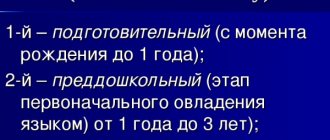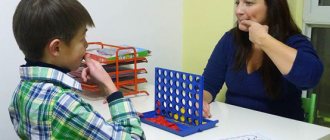Theoretical foundations of speech therapy. Principles and methods of speech therapy
Speech therapy is based on the following basic principles: systematicity, complexity, development principle, consideration of speech disorders in connection with other aspects of the child’s mental development, activity approach, ontogenetic principle, principle of taking into account etiology and mechanisms (etiopathogenetic principle), principle of taking into account the symptoms of the disorder and the structure of the speech defect , the principle of a workaround, general didactic and other principles. Let's look at some of them.
The principle of systematicity is based on the idea of speech as a complex functional system, the structural components of which are in close interaction. In this regard, the study of speech, the process of its development and correction of disorders involves influencing all components, all aspects of the speech functional system.
For a speech therapy conclusion, for the differential diagnosis of similar forms of speech disorders, a correlation analysis of speech and non-speech symptoms, data from a medical, psychological, speech therapy examination, correlation of the levels of development of cognitive activity and speech, the state of speech and the characteristics of the sensorimotor development of the child are necessary.
Speech disorders in many cases are included in the syndrome of nervous and neuropsychiatric diseases (for example, dysarthria, alalia, stuttering, etc.). Elimination of speech disorders in these cases should be comprehensive, medical, psychological and pedagogical in nature.
Thus, when studying and eliminating speech disorders, the principle of complexity is important .
In the process of studying speech disorders and their correction, it is important to take into account the general and specific patterns of development of abnormal children.
The principle of development involves identifying in the process of speech therapy work those tasks, difficulties, and stages that are in the zone of proximal development of the child.
The study of children with speech disorders, as well as the organization of speech therapy work with them, is carried out taking into account the child’s leading activities (subject-practical, play, educational).
The development of a methodology for correctional speech therapy is carried out taking into account the sequence of appearance of the forms and functions of speech, as well as the types of activities of the child in ontogenesis (ontogenetic principle).
The occurrence of speech disorders in many cases is due to a complex interaction of biological and social factors. For successful speech therapy correction of speech disorders, it is of great importance to establish in each individual case the etiology, mechanisms, symptoms of the disorder, identification of leading disorders , and the ratio of speech and non-speech symptoms in the structure of the defect.
In the process of compensating for impaired speech and non-speech functions and restructuring the activities of functional systems, the principle of a workaround , i.e., the formation of a new functional system bypassing the affected link.
An important place in the study and correction of speech disorders is occupied by didactic principles: clarity, accessibility, awareness, individual approach, etc.
The methods of speech therapy as a science can be divided into several groups.
The first group is organizational methods: comparative, longitudinal (study over time), complex.
The second group consists of empirical methods: observational (observation), experimental (laboratory, natural, formative or psychological-pedagogical experiment), psychodiagnostic (tests, standardized and projective, questionnaires, conversations, interviews), praximetric examples of activity analysis, including speech activities, biographical (collection and analysis of anamnestic data).
The third group includes quantitative (mathematical-statistical) and qualitative analysis of the data obtained; machine data processing using a computer is used.
The fourth group is interpretive methods, methods of theoretical study of connections between the phenomena being studied (the connection between parts and the whole, between individual parameters and the phenomenon as a whole, between functions and personality, etc.).
Technical means are widely used to ensure the objectivity of the study: intonographs, spectographs, nasometers, video speech, phonographs, spirometers and other equipment, as well as X-ray cine photography, glottography, cinematography, electromyography, which make it possible to study the dynamics of integral speech activity and its individual components.
Classification of general speech underdevelopment in speech therapy
In terms of clinical composition, the category of children with general speech underdevelopment is heterogeneous. Speech therapists distinguish the following forms of pathology:
- uncomplicated forms of general speech underdevelopment in children with minimal disorders of brain function - insufficient regulation of muscle tone, immaturity of the emotional-volitional sphere, motor differentiation);
- complicated forms of OHP in children with psychopathic and neurological syndromes - cerebrasthenic, convulsive, hypertensive-hydrocephalic, hyperdynamic;
- gross underdevelopment of speech in children with organic lesions of the speech parts of the brain (with motor alalia - the absence or underdevelopment of speech in children with normal hearing and initially intact intelligence).
The following classification of speech disorders in speech therapy is currently used:
- the first level of speech development is “speechless children” who lack common speech;
- the second level of speech development - the initial elements of common speech, a poor vocabulary, and the phenomena of agrammatism are determined - speech disorders manifested in difficulties in generating or perceiving sentences;
- the third level of speech development is the appearance of expanded phrasal speech with underdevelopment of its semantic and sound aspects;
- the fourth level of speech development – residual gaps in the development of the lexical-grammatical and phonetic-phonemic aspects of speech.
The importance of speech therapy
THE IMPORTANCE OF Speech Therapy
Speech therapy as a science has important theoretical and practical significance, which is determined by the social essence of language, speech, the close connection between the development of speech, thinking and all mental activity of the child.
Speech function is one of the most important mental functions of a person.
In the process of speech development, higher forms of cognitive activity and the ability to conceptual thinking are formed. The meaning of a word in itself is a generalization and, in connection with this, represents not only a unit of speech, but also a unit of thinking. They are not identical and arise to some extent independently of each other. But in the process of the child’s mental development, a complex, qualitatively new unity arises - speech thinking, speech-thinking activity.
Mastering the ability to communicate verbally creates the prerequisites for specifically human social contacts, thanks to which the child’s ideas about the surrounding reality are formed and refined, and the forms of its reflection are improved.
A child’s mastery of speech contributes to awareness, planning and regulation of his behavior. Speech communication creates the necessary conditions for the development of various forms of activity and participation in collective work.
Speech disorders to one degree or another (depending on the nature of the speech disorders) negatively affect the entire mental development of the child and affect his activities and behavior. Severe speech disorders can affect mental development, especially the formation of higher levels of cognitive activity, which is due to the close relationship between speech and thinking and the limited social, in particular speech, contacts, during which the child learns about the surrounding reality.
Speech disorders and limited verbal communication can negatively affect the formation of a child’s personality, cause mental layers, specific features of the emotional-volitional sphere, and contribute to the development of negative character traits (shyness, indecisiveness, isolation, negativism, feelings of inferiority).
All this negatively affects literacy, academic performance in general, and choice of profession. The importance of speech therapy is to help the child overcome speech disorders, thereby ensuring his full, comprehensive development.
Speech therapist's personality
A speech therapist must have a system of general theoretical and special professional knowledge, the totality and breadth of which forms his ideas about the typology and structure of abnormal development, about ways to prevent and overcome speech insufficiency, about methods of psychological and pedagogical influence.
A speech therapist must be able to recognize speech disorders, possess techniques and methods for their elimination and correction, special methods of teaching children with speech disorders their native language both in preschool and school age, carry out preventive work to prevent academic failure, and have a good knowledge of the psychological characteristics of children with speech pathology , use techniques and methods for their education, correlation and development of their higher cortical functions.
Success in performing these tasks depends on the speech therapist having deep professional knowledge and skills, broad orientation in modern domestic and foreign achievements of sciences related to speech therapy, as well as on his creative activity and initiative. The professional competence of a speech therapist includes knowledge of programs, school textbooks, and speech therapy manuals.
Of primary importance for the effectiveness of work on training, education, correction and prevention of speech disorders in children is the personality of a speech therapist, which is characterized by the following qualities:
humanistic conviction; civic moral maturity; cognitive and pedagogical orientation; passion for the profession; love for children; demanding of oneself and others; fairness, endurance and self-criticism; pedagogical creative imagination and observation; sincerity, modesty, responsibility, firmness and consistency in words and actions, etc.
The speech therapist should search for the best means of correcting children’s speech, studying and summarizing best practices.
The skills that he must possess are wide and varied: educational and cognitive (working with literature, observing the child and the pedagogical process; modeling the pedagogical process, choosing the optimal ways of correctional and educational influence, etc.); educational and organizational (long-term and calendar planning, conducting individual and group classes, creating equipment, ensuring the complexity of the impact and determining one’s real participation in this complex, etc.); educational and pedagogical (analysis of each case, selection of adequate means of correction, etc.).
In addition, the work of a speech therapist should be based on strict adherence to the principles of deontology (a system of interactions with a person with a speech disorder, with his relatives and work colleagues).
Pedagogical deontology includes the doctrine of pedagogical ethics and aesthetics, pedagogical duty and morality. Compliance with it requires the speech therapist to understand the psychology of the parents of a child with speech disorders and empathize with them. The speech therapist must be patient, tactful and friendly, treat a person with speech pathology and his parents the way a doctor treats a patient and his relatives, be careful in assessing the severity and especially the mechanisms, speech disorders, prognosis, take into account the external manifestations of speech disorders, their essence, since many of them, even mildly expressed, can be only one of the manifestations of severe neuropsychiatric diseases.
An important condition for pedagogical deontology is the establishment of correct relationships between a speech therapist and a doctor at a child care institution, a speech therapist and a teacher, a speech therapist and a teacher.
The work of a speech therapist is based on the conclusion of a doctor - a neurologist or psychoneurologist - about the child. Joint discussion with colleagues of the most complex types of speech disorders in an atmosphere of mutual understanding and mutual respect creates a favorable environment for carrying out correctional work.
The speech of a speech therapist should be a model for others, not only children, but also adults. The speech therapist provides a unified speech regime, advises middle and junior staff of special children's institutions, and in some cases heads the entire educational process, for example, in special children's homes.
Compliance with the rules of pedagogical deontology is of paramount importance in increasing the effectiveness of correctional speech therapy work.
CURRENT PROBLEMS OF MODERN Speech Therapy
Currently, there has been significant progress in the development of speech therapy. Based on psychological analysis, important data were obtained on the mechanisms of the most complex forms of speech pathology (aphasia, alalia and general speech underdevelopment, dysarthria). Speech disorders are studied in complicated defects: in mental retardation, in children with visual, hearing, and musculoskeletal impairments. Modern neurophysiological and neuropsychological research methods are being introduced into speech therapy practice. The relationship between speech therapy and clinical medicine, child neuropathology and psychiatry is expanding.
Speech therapy at an early age is developing intensively: the features of pre-speech development of children with organic damage to the central nervous system are being studied, criteria for early diagnosis and prognosis of speech disorders are being determined, techniques and methods of preventive (preventing the development of a defect) speech therapy are being developed. All these areas of research have significantly increased the effectiveness of speech therapy work.
Due to the fact that correct speech is one of the most important prerequisites for the further full development of the child and the process of social adaptation, the identification and elimination of speech disorders must be carried out at an earlier date. The effectiveness of eliminating speech disorders is determined largely by the level of development of speech therapy as a science.
The study of speech therapy is important for all workers in children's, especially preschool, institutions. A significant percentage of speech disorders manifests itself in preschool age, since this age is a sensitive period for speech development. Timely detection of speech disorders contributes to their faster elimination and prevents the negative impact of speech disorders on the formation of personality and on the entire mental development of the child.
Knowledge of speech therapy is important for all speech pathologists, since speech disorders are much more common in abnormal children than in normally developing children.
The most pressing problems of modern speech therapy are the following:
1. Unification of the categorical apparatus.
2. In-depth study of mechanisms (including psycholinguistic) and methods for correcting speech disorders.
3. Scientifically based correlation of nosological (clinical-pedagogical) and symptomological (psychological-pedagogical) approach in speech therapy theory and practice and in the development of nomenclature documents.
4. Study of the ontogenesis of speech in various forms of speech disorders.
5. Study of the characteristics of speech disorders and their elimination in complicated developmental defects.
6. Early prevention, identification and elimination of speech disorders.
7. Creative and scientifically based development of content, methods of teaching and raising children with severe speech impairments and special kindergartens and schools.
8. Consistent implementation of an integrated approach to identifying and correcting speech disorders.
9. Ensuring continuity in speech therapy work in preschool, school and medical institutions.
10. Improving the theory and practice of differential diagnosis of various forms of speech disorders.
11. Development of technical technical support, laboratory and experimental equipment, introduction of computer technology into the educational process.
12. Analysis of achievements in the theory and practice of domestic and foreign speech therapy.
Increased originality
Test questions 1. Explain the essence of the phenomenon of viscous friction. What is the nature of the internal friction forces of a fluid? Viscosity or internal friction is the property of fluid bodies (liquids and gases) to resist the movement of one part relative to another. This phenomenon determines the dissipation (absorption) of energy during deformation of the medium. During shear deformation, the viscosity is called shear viscosity. When the volume is deformed (universal compression), bulk viscosity appears. In this case, we will only touch upon the issue of shear viscosity. The essence of the phenomenon is that moving layers of gas or liquid entrain neighboring layers and, conversely, stationary layers (or moving at a lower speed) slow down faster neighboring layers. Thus, internal friction forces (or viscous forces) act between any adjacent layers of the medium under consideration. The mechanism by which these forces arise is the transfer of momentum (amount of motion) from one layer to another.2. What is the coefficient of dynamic viscosity? In what units is viscosity measured in the SI system?
The coefficient of dynamic viscosity is a value numerically equal to the force of internal friction with which one layer drags or slows down another layer of liquid, provided that the contact area of the layers and the velocity gradient . In the SI system, the unit of dynamic viscosity is taken to be the viscosity of a medium in which one layer drags or inhibits another with a force of , if the contact area of the layers and the velocity gradient are .
3. What forces act on a body moving in a liquid?
A body immersed in a liquid and remaining in equilibrium afloat is acted upon by two forces: the force of gravity and the buoyant force equal to it (and equal to the weight of the liquid displaced by the immersed volume of the body). Three forces act on a body immersed in a liquid and sinking: the force of gravity, which is unequal to it (less), the buoyancy force (equal to the weight of the liquid displaced by the immersed volume of the body), as well as the frictional force during movement, which largely depends on the speed of immersion and the viscosity of the liquid . A body immersed in a liquid and lying tightly at the bottom is acted upon by three forces: the force of gravity, the unequal buoyant force, and the reaction force from the bottom. In this case, the buoyant force decreases by an amount equal to the weight of the liquid occupied by that part of the body volume under which there is no water
4. Define laminar and turbulent fluid flow.
Turbulent flow is a fluid flow in which its particles perform unsteady and disordered movements along complex trajectories, leading to mixing of layers. Laminar is an ordered flow of fluid in which the trajectories of motion of neighboring particles differ little from each other.
5. Write down the Stokes formula and indicate the conditions for its applicability.
For spherical bodies, the modulus of the viscous friction force is determined by the Stokes formula (1) where r is the radius of the ball; V is the speed of its movement relative to the liquid. It is important to note that formula (1) is valid only in the case of laminar fluid flow relative to the ball (the speed of the ball should be small), and the fluid extends infinitely in all directions, i.e. The dimensions of the vessel in which the liquid is located must be much larger compared to the dimensions of the ball.
6. Determine the magnitude of the friction force acting on a steel ball with a diameter of 3 mm falling at a speed of 0.75 m/s in a liquid with a viscosity coefficient of 1.5 Pa.s. F=6*3.14*1.5*0.003*0. 5=0.063
7. Why does the ball accelerate at the beginning of its movement and then move uniformly? What is a velocity gradient? At the beginning of the ball's movement, the movement will be accelerated due to the acceleration of gravity. As the speed increases, the resistance force also increases, and the acceleration of the ball decreases. There comes a moment when the forces acting on the ball are balanced, the acceleration becomes zero, and the movement of the ball becomes uniform in section L. The velocity gradient is the change in the speed of two layers of liquid dV at the distance between the layers dX.
8. Write down the working formula, explain the conditions for its use and the reason for starting to measure time not from the surface of the liquid.
The upper mark is placed several centimeters below the upper level of the liquid to ensure uniform movement of the ball in the liquid. 9. List the main sources of measurement errors carried out in this work.






